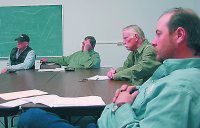| Extension agent Marlon Winger and Carbon County livestock producers watch a teleconference from Utah State University. The teleconference was set up to explain the emergency distribution of nonfat dry milk to ranchers and farmers as a supplement to feed for cattle in an area which has faced severe drought conditions for the last four years. |
Coming up with a plan to distribute dry milk to drought impacted ranchers and farmers in Utah has been challenging.
In fact, the process is being designed as the distribution proceeds, indicate officials from the Utah Department of Agriculture and Food and Utah State University Extension Service.
“This is a lot like the rebuilding of Interstate 15 a few years ago,” commented Larry Lewis of USU extension, during a video teleconference Wednesday morning. “We have never done anything like this before so we are in a design as you go stage of putting this whole operation together.”
Lewis explained that there are two phases to the operation so far with the application process being one and the other being the actual distribution of the nonfat dry milk (NDM).
“This is a nine state program the federal government has set up and it is fairly complicated,” explained Lewis. “There is a billion pounds of the product available to those states of which Utah will be getting approximately 8.9 million. While it was designated for only a dozen counties, the governor and the agricultural commission have gotten together and decided to offer it to qualified applicants in all 29 counties of the state.”
The applications for receiving the NDM were sent out to known qualified ranchers and farmers in Carbon County on April 23. The completed applications are due at the state office by May 5.
“There will be approximately 208 semi-truck loads being brought into the state,” remarked Lewis. “The amount various operations in agriculture get is based on their application and the information they provide. We are working on an honor system with those in agriculture to tell us how many livestock they have so we can prorate the amount each needs.”
Once the applications are in and the product arrives, it will be sent to various distribution points all over the state.
In Carbon County, the point of distribution will be in the industrial park south of Price. In Emery County, the point of distribution will be at Cash Winns.
“The product will come in 55 lb. sacks that will be triple wrapped and probably on pallets that will be shrink wrapped,” stated Lewis. “It will be sent to those approved points and distributed.”
The milk is free to qualifying farmers and ranchers, but there may be some cost for distribution and storage if needed.
“The federal government is sending it to us without cost, which includes shipping into Utah,” noted Lewis. “But within the state, there will be some costs. We’re not sure what they will be at this point.”
The nonfat dried milk will need to be stored in areas that have temperatures below 80 degrees Fahrenheit and must be kept away from moisture. Otherwise, the supplement will harden and become difficult to feed to livestock.
Based on a price of $80 per ton, the Utah supply is worth about $365,000 and will be a 30 day renewable resource. The government may release additional dried milk depending on how the drought proceeds.
The USDA has decided to make the milk available because it has passed it’s expiration for human consumption and is costing a great deal of money for storage.
A problem that arose Tuesday involved the question of third party distribution. All farmers and ranchers who receive the milk will be required to sign a waiver, taking all liability away from the suppliers, shippers and distributors. The same will be expected of individuals who may attempt to third party market the dried milk feed supplement.
If the product is fed improperly to cattle, the milk can make the animals sick or even kill livestock, according to USU.
In addition, there is concern that some of the milk could end up being secured by people who may want to put the expired product back into the human food chain. The dried nonfat milk is intended to be used by livestock owners and only for foundation herds.
The use of the milk comes with a number of cautions. It is only a supplement for beef, buffalo, sheep and goats, not a main feeding source, pointed out USU. It is not what is called a “free choice” feed for cattle, but must be mixed thoroughly and uniformly with livestock feed.

